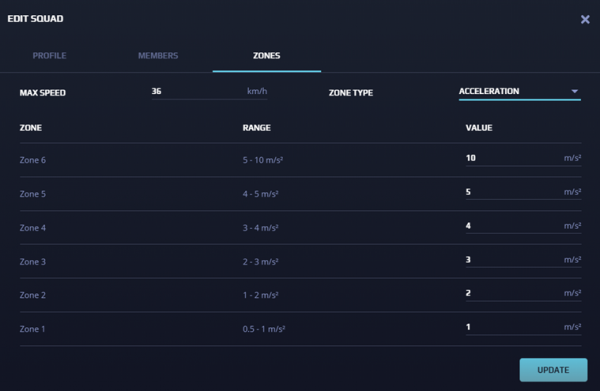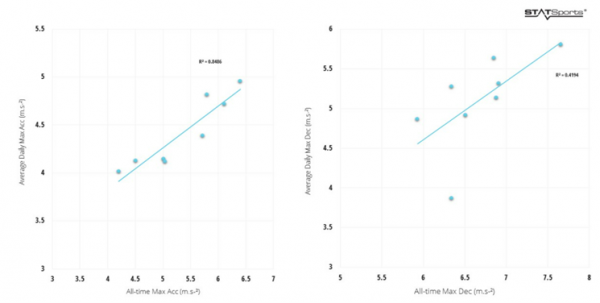
03 May APPLICATION OF ABSOLUTE AND INDIVIDUALIZED ACCELERATION & DECELERATION ZONES TO QUANTIFY EXTERNAL TRAINING LOAD WITH STATSPORTS SONRA
INTRODUCTION
Team sport players are called more and more frequently to carry out activities at maximum or sub-maximal intensity, often with very short recovery bouts.
The result of the game is in most cases decided by high intensity actions of this type.
Quantifying high intensity actions such as acceleration & decelerations is paramount not only for successful athletic performance, but it also important for coaches to manage athlete load [1].
In fact, research [2] has shown an increased level of creatine kinase (CK) when a high count of high-intensity accelerations & decelerations were performed.
Accelerations & Decelerations are variables that can be then viewed as a good indicators of muscle damage and help coaches in prescribing training & recovery strategies.
ABSOLUTE & INDIVIDUALIZED ZONES
The considerations of when we select the accelerations zones depends on the purpose of what we are using the data for.
If want to compare between individuals we may utilize Absolute Zones, which are standard criteria measures valid for the entire squad.
For acceleration and deceleration absolute zones, the threshold of +3 and−3 m·s−2 for high acceleration and deceleration, respectively, is commonly utilized by practitioners.
With this, practitioners can then look at distance covered, time spent and count of actions above these criteria.
To set Absolute Zones with Sonra software, the team must be selected in the “Player Management” Section and Acceleration/Deceleration Absolute Zones will be able to be customized (figure below) for all 6 zones and applied to all members, regardless of their physical capacities.

However, if we want to individualize zones according to fitness level and assess players exertion over time or during performance, we might want to use relative zones.
This is more laborious but certainly more precise in understanding the individual player responsiveness of training load.
The relative zones that we select for our athletes should be relevant to their fitness level, training status and the level of competition they are competing in.
Athletes will experience a different stress based on the magnitude of maximum acceleration & decelerations efforts that they are able to achieve.
Abbott et al. found significant discrepancies between acceleration distances calculated using absolute and relative acceleration thresholds, which were dependent on athletes’ maximum accelerative capacities [3].
As stated by the previous STATSports insight (https://pro.statsports.com/maximum-acceleration-and-deceleration-metric-considerations-and-uses/) positive relationships were seen between both all-time maximum accelerations and average daily Maximum Acceleration (and all-time Maximum Deceleration and average daily Maximum Deceleration), due to a lower metabolic cost to perform sub maximal acceleration /deceleration efforts during sessions.

To accommodate these needs, Sonra software allows practitioners to customize relative zones based on the % of Max Acceleration, in the “General Settings – Format “section.

Player maximum Acceleration & Decelerations values can be assessed by collecting a data over time and regularly check for New Max Values achieved to create a profile on athletes.
A longitudinal analysis approach will ensure the athletes will cover the entire spectrum of acceleration data and utilize the values with confidence.
All 6 accelerations & decelerations bands will be then set individually in the player profile based on the % of their peak (Example below, Zone 1 to 6 for a player with a Top Acceleration of 5.5 m/s2).

From an injury prevention standpoint, there are certain situations along the season where we may not want to expose the player to violent accelerations (beginning of pre-season, Return to Play sessions, etc.), as they may not have built the capacity to tolerate these forces yet.
As shown in the research of Beato et al. higher acceleration intensity produced higher mechanical and physiological stress compared to submaximal accelerations [4].
The knowledge of athlete’s daily performance relative to his potential, is paramount to prescribe the appropriate training intensity and volume along the different stages of the season.
Conclusion
The ability to produce powerful Accelerations & Decelerations has a significant impact on the results in professional sports.
When both absolute and individualised thresholds are used in conjunction, greater insights into the player loading of individuals and teams may be achieved than with either method alone.
Athletes that have a better peak acceleration and deceleration capacity will tend to show this characteristic on a daily basis.
From an injury prevention standpoint, knowing the physical characteristics of the athlete will help coaches to strategically design training load, helping in reducing illness, injuries and to maximise recovery.
Author Details
Name: Alberto Silingardi
Department: Account Manager – Sports Science
Email Address: [email protected]
References
- Delves RIM, Aughey RJ, Ball K, Duthie GM. The Quantification of Acceleration Events in Elite Team Sport: a Systematic Review. Sports Med Open. 2021 Jun 30;7(1):45. doi: 10.1186/s40798-021-00332-8. PMID: 34191142; PMCID: PMC8245618
- Young WB, Hepner J, Robbins DW. Movement demands in Australian rules football as indicators of muscle damage. J Strength Cond Res. 2012 Feb;26(2):492-6. doi: 10.1519/JSC.0b013e318225a1c4. PMID: 22233791.
- Abbott, Will & Brickley, Gary & Smeeton, Nicholas & Mills, Stuart. (2018). Individualizing Acceleration in English Premier League Academy Soccer Players. Journal of Strength and Conditioning Research. 32. 1. 10.1519/JSC.0000000000002875.
- Beato, Marco & Drust, Barry. (2020). Acceleration intensity is an important contributor to the external and internal training load demands of repeated sprint exercises. Research in Sports Medicine. 29. 10.1080/15438627.2020.1743993.
- MAXIMUM ACCELERATION AND DECELERATION – METRIC CONSIDERATIONS AND USES –https://pro.statsports.com/maximum-acceleration-and-deceleration-metric-considerations-and-uses/